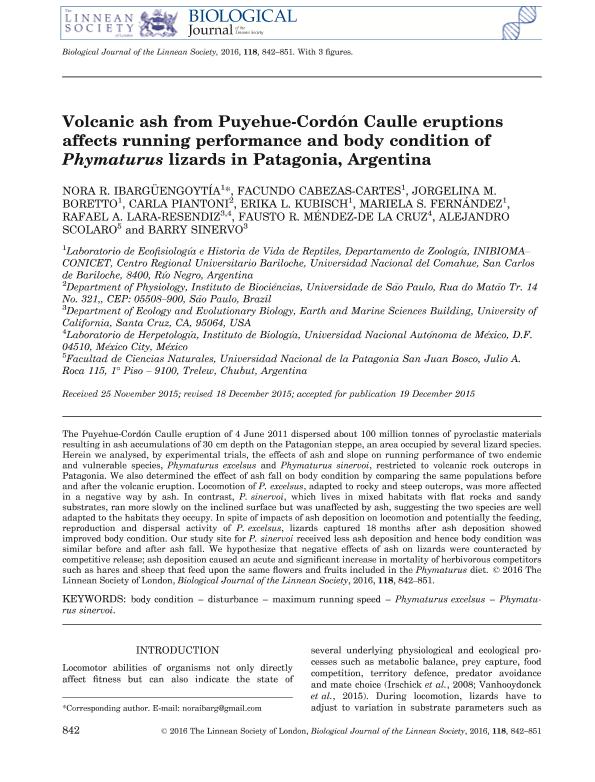Mostrar el registro sencillo del ítem
dc.contributor.author
Ibarguengoytía, Nora

dc.contributor.author
Cabezas, Facundo

dc.contributor.author
Boretto, Jorgelina Mariela

dc.contributor.author
Piantoni, Carla

dc.contributor.author
Kubisch, Erika Leticia

dc.contributor.author
Fernández, Mariela

dc.contributor.author
Lara Resendiz, Rafael A.

dc.contributor.author
Méndez de la Cruz, Fausto Roberto

dc.contributor.author
Scolaro, Jose Alejandro

dc.contributor.author
Sinervo, Barry Raymond

dc.date.available
2018-02-21T20:49:08Z
dc.date.issued
2016-08-18
dc.identifier.citation
Ibarguengoytía, Nora; Cabezas, Facundo; Boretto, Jorgelina Mariela; Piantoni, Carla; Kubisch, Erika Leticia; et al.; Volcanic ash from Puyehue-Cordón Caulle eruptions affects running performance and body condition of Phymaturus lizards in Patagonia, Argentina; Wiley Blackwell Publishing, Inc; Biological Journal of The Linnean Society; 118; 4; 18-8-2016; 842-851
dc.identifier.issn
0024-4066
dc.identifier.uri
http://hdl.handle.net/11336/36928
dc.description.abstract
The Puyehue-Cordón Caulle eruption of 4 June 2011 dispersed about 100 million tonnes of pyroclastic materials resulting in ash accumulations of 30 cm depth on the Patagonian steppe, an area occupied by several lizard species. Herein we analysed, by experimental trials, the effects of ash and slope on running performance of two endemic and vulnerable species, Phymaturus excelsus and Phymaturus sinervoi, restricted to volcanic rock outcrops in Patagonia. We also determined the effect of ash fall on body condition by comparing the same populations before and after the volcanic eruption. Locomotion of P. excelsus, adapted to rocky and steep outcrops, was more affected in a negative way by ash. In contrast, P. sinervoi, which lives in mixed habitats with flat rocks and sandy substrates, ran more slowly on the inclined surface but was unaffected by ash, suggesting the two species are well adapted to the habitats they occupy. In spite of impacts of ash deposition on locomotion and potentially the feeding, reproduction and dispersal activity of P. excelsus, lizards captured 18 months after ash deposition showed improved body condition. Our study site for P. sinervoi received less ash deposition and hence body condition was similar before and after ash fall. We hypothesize that negative effects of ash on lizards were counteracted by competitive release; ash deposition caused an acute and significant increase in mortality of herbivorous competitors such as hares and sheep that feed upon the same flowers and fruits included in the Phymaturus diet.
dc.format
application/pdf
dc.language.iso
eng
dc.publisher
Wiley Blackwell Publishing, Inc

dc.rights
info:eu-repo/semantics/openAccess
dc.rights.uri
https://creativecommons.org/licenses/by-nc-sa/2.5/ar/
dc.subject
Body Condition
dc.subject
Disturbance
dc.subject
Maximum Running Speed
dc.subject
Phymaturus Excelsus
dc.subject
Phymaturus Sinervoi
dc.subject.classification
Otras Ciencias Biológicas

dc.subject.classification
Ciencias Biológicas

dc.subject.classification
CIENCIAS NATURALES Y EXACTAS

dc.title
Volcanic ash from Puyehue-Cordón Caulle eruptions affects running performance and body condition of Phymaturus lizards in Patagonia, Argentina
dc.type
info:eu-repo/semantics/article
dc.type
info:ar-repo/semantics/artículo
dc.type
info:eu-repo/semantics/publishedVersion
dc.date.updated
2018-02-15T16:55:44Z
dc.identifier.eissn
1095-8312
dc.journal.volume
118
dc.journal.number
4
dc.journal.pagination
842-851
dc.journal.pais
Reino Unido

dc.journal.ciudad
Londres
dc.description.fil
Fil: Ibarguengoytía, Nora. Consejo Nacional de Investigaciones Científicas y Técnicas. Centro Científico Tecnológico Conicet - Patagonia Norte. Instituto de Investigaciones en Biodiversidad y Medioambiente. Universidad Nacional del Comahue. Centro Regional Universidad Bariloche. Instituto de Investigaciones en Biodiversidad y Medioambiente; Argentina
dc.description.fil
Fil: Cabezas, Facundo. Consejo Nacional de Investigaciones Científicas y Técnicas. Centro Científico Tecnológico Conicet - Patagonia Norte. Instituto de Investigaciones en Biodiversidad y Medioambiente. Universidad Nacional del Comahue. Centro Regional Universidad Bariloche. Instituto de Investigaciones en Biodiversidad y Medioambiente; Argentina
dc.description.fil
Fil: Boretto, Jorgelina Mariela. Consejo Nacional de Investigaciones Científicas y Técnicas. Centro Científico Tecnológico Conicet - Patagonia Norte. Instituto de Investigaciones en Biodiversidad y Medioambiente. Universidad Nacional del Comahue. Centro Regional Universidad Bariloche. Instituto de Investigaciones en Biodiversidad y Medioambiente; Argentina
dc.description.fil
Fil: Piantoni, Carla. Universidad de Sao Paulo; Brasil
dc.description.fil
Fil: Kubisch, Erika Leticia. Consejo Nacional de Investigaciones Científicas y Técnicas. Centro Científico Tecnológico Conicet - Patagonia Norte. Instituto de Investigaciones en Biodiversidad y Medioambiente. Universidad Nacional del Comahue. Centro Regional Universidad Bariloche. Instituto de Investigaciones en Biodiversidad y Medioambiente; Argentina
dc.description.fil
Fil: Fernández, Mariela. Consejo Nacional de Investigaciones Científicas y Técnicas. Centro Científico Tecnológico Conicet - Patagonia Norte. Instituto de Investigaciones en Biodiversidad y Medioambiente. Universidad Nacional del Comahue. Centro Regional Universidad Bariloche. Instituto de Investigaciones en Biodiversidad y Medioambiente; Argentina
dc.description.fil
Fil: Lara Resendiz, Rafael A.. University of California; Estados Unidos. Universidad Nacional Autónoma de México; México
dc.description.fil
Fil: Méndez de la Cruz, Fausto Roberto. Universidad Nacional Autónoma de México; México
dc.description.fil
Fil: Scolaro, Jose Alejandro. Universidad Nacional de la Patagonia; Argentina. Consejo Nacional de Investigaciones Científicas y Técnicas; Argentina
dc.description.fil
Fil: Sinervo, Barry Raymond. Universidad de California; Estados Unidos
dc.journal.title
Biological Journal of The Linnean Society

dc.relation.alternativeid
info:eu-repo/semantics/altIdentifier/doi/http://dx.doi.org/10.1111/bij.12778
dc.relation.alternativeid
info:eu-repo/semantics/altIdentifier/url/https://academic.oup.com/biolinnean/article/118/4/842/2705718
Archivos asociados
